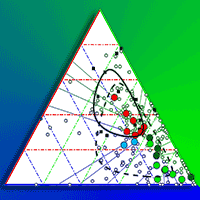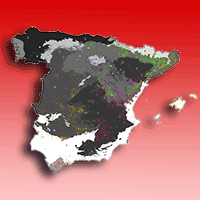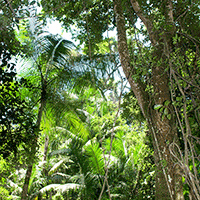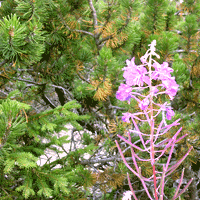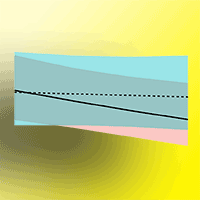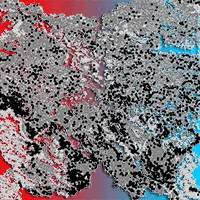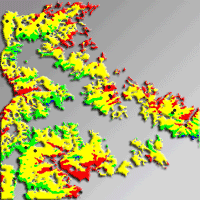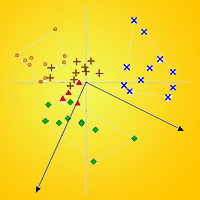
Typology and synecology of aspen woodlands in the central-southern Apennines (Italy): new findings and synthesis
Giovanni Russo (1), Franco Pedrotti (2), Dan Gafta (3)
iForest - Biogeosciences and Forestry, Volume 13, Issue 3, Pages 202-208 (2020)
doi: https://doi.org/10.3832/ifor3315-013
Published: May 19, 2020 - Copyright © 2020 SISEF
Research Articles
Abstract
In order to review and complete our knowledge of the typology and synecology of the aspen communities from the central-southern Apennines, ten original relevés were performed on the Gargano plateau and a set of 35 relevés assigned to four community types (HP: Holco mollis-Populetum tremulae; MP: Melico uniflorae-Populetum tremulae; FP: Fraxino orni-Populetum tremulae; GP: Geranio versicoloris-Populetum tremulae) were assembled from literature. These relevés along with several environmental variables either measured or estimated were involved in cluster and ordination analyses. The relevés from Gargano formed a distinctive cluster and were assigned to a new community type (SP: Stellario holosteae-Populetum tremulae ass. nova), which can be considered an Adriatic synvicariant of HP that is distributed in similar habitats (doline bottoms) but on the Tyrrhenian escarpment. At low levels of floristic similarity, the grouping of relevés in two clusters induces a sharp separation between the aspen communities distributed in the central Apennines (MP and FP) and those from the southern Apennines (SP, HP and GP), which is mainly due to compositional differences in the regional species pool. The ordination scores of relevés were best related to terrain slope, soil nitrogen, elevation, air temperature, light availability and, to a lesser extent, to soil moisture and reaction. Unlike MP and GP that appear the most mesophilous, the FP stands display a slightly more xerophilous and acidophilous character induced by the steeper slopes on which they occur. The HP habitat is the driest and lightest very likely because of the open overlying canopy, in contrast to MP stands featuring a high shrub cover. The highest occurrence of nitrophilous species was observed in SP and MP. The management of these pioneer woods should be aimed at conservation, as they play an important role in the recovery of forest herb diversity along the ecological succession towards hardwood forests.
Keywords
Differential Species, Distribution Area, Environmental Variable Fitting, Gargano, Multivariate Analyses, Phytosociologic Classification, Secondary Succession, Stellario holosteae-Populetum tremulae
Authors’ Info
Authors’ address
Department of Biosciences, University of Camerino, Camerino (Italy)
Department of Taxonomy and Ecology, Babes-Bolyai University, Cluj-Napoca (Romania)
Corresponding author
Paper Info
Citation
Russo G, Pedrotti F, Gafta D (2020). Typology and synecology of aspen woodlands in the central-southern Apennines (Italy): new findings and synthesis. iForest 13: 202-208. - doi: 10.3832/ifor3315-013
Academic Editor
Michele Carbognani
Paper history
Received: Dec 06, 2019
Accepted: Mar 28, 2020
First online: May 19, 2020
Publication Date: Jun 30, 2020
Publication Time: 1.73 months
Copyright Information
© SISEF - The Italian Society of Silviculture and Forest Ecology 2020
Open Access
This article is distributed under the terms of the Creative Commons Attribution-Non Commercial 4.0 International (https://creativecommons.org/licenses/by-nc/4.0/), which permits unrestricted use, distribution, and reproduction in any medium, provided you give appropriate credit to the original author(s) and the source, provide a link to the Creative Commons license, and indicate if changes were made.
Web Metrics
Breakdown by View Type
Article Usage
Total Article Views: 39247
(from publication date up to now)
Breakdown by View Type
HTML Page Views: 33755
Abstract Page Views: 2463
PDF Downloads: 2261
Citation/Reference Downloads: 1
XML Downloads: 767
Web Metrics
Days since publication: 2050
Overall contacts: 39247
Avg. contacts per week: 134.01
Citation Metrics
Article Citations
Article citations are based on data periodically collected from the Clarivate Web of Science web site
(last update: Mar 2025)
Total number of cites (since 2020): 3
Average cites per year: 0.50
Publication Metrics
by Dimensions ©
Articles citing this article
List of the papers citing this article based on CrossRef Cited-by.
References
The vegetation series in the Region Apulia. In: “The Vegetation of Italy” (Blasi C ed). Palumbi Editore, Rome, Italy, pp. 391-409.
Gscholar
Increase in soil aggregate stability along a Mediterranean successional gradient in severely eroded gully bed ecosystems: combined effects of soil, root traits and plant community characteristics. Plant and Soil 398: 121-137.
CrossRef | Gscholar
The vegetation and dynamical tendencies in the vegetation of Bosco Quarto, Promontorio del Gargano, Italy. Braun-Blanquetia 5: 1-31.
Gscholar
The vegetation of the Maddalena Mountains (southern Italy). Plant Sociology 50: 5-37.
Gscholar
Vegetation of Europe: hierarchical floristic classification system of vascular plant, bryophyte, lichen, and algal communities. Applied Vegetation Science (Suppl 1) 19: 3-264.
CrossRef | Gscholar
The trembling poplar woods of the central Apennines. Studi Trentini di Scienze Naturali - Acta Biologica 70: 99-105. [in Italian]
Gscholar
The trembling poplar (Populus tremula) colonising the abandoned fields in the Abruzzo National Park. In: “Phytodynamics - The Different Aspects of Vegetation Dynamics” (Biondi E, Gehu JM eds). Colloques Phytosociologiques 24, J. Cramer, Berlin, pp. 111-121. [in Italian]
Gscholar
Bioindicator values of vascular plants of the flora of Italy. Braun-Blanquetia 39: 1-97. [in Italian]
Gscholar
Biogeographic map of Europe. Scale 1:16.000.000. Cartographic Service, University of Leon, Spain.
Gscholar
The forest vegetation of the Alburni Mts. (Cilento National Park, Campania, southern Italy): syntaxonomy and phytogeography. Fitosociologia 47: 17-55. [in Italian]
Gscholar
The abandoned fields: a new component of the landscape. Bolletino della Società Geografica Italiana 5: 441-464. [in Italian]
Gscholar
The vegetation of the Gargano National Park (Promontory of Gargano and Tremiti Islands). In: Proceedings of the “Stelvio Congress” (Pedrotti F ed). Colloques Phytosociologiques 29, J. Cramer, Berlin, Germany, pp. 577-603. [in Italian]
Gscholar
Vegetation series of the geomorphological system of Mount Ascensione (central Italy). Fitosociologia 37: 93-151. [in Italian]
Gscholar

